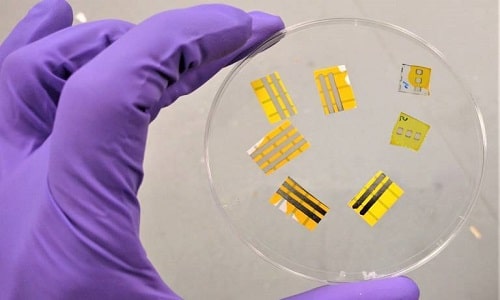The technology uses organic light-emitting diodes (OLEDs) that are fabricated on to temporary tattoo paper

Scientists at the University College London (UCL) and the Italian Institute of Technology (Istituto Italiano di Tecnologia – IIT) have created a temporary tattoo with light-emitting technology that can be used in TV and smartphone screens.
The researchers say it could be combined with other tattoo electronics, for instance, to emit light when an athlete is dehydrated or when we need to get out of the sun to avoid sunburn. OLEDs could be tattooed on packaging or fruit to signal when a product has passed its expiry date or will soon become inedible.
“The tattooable OLEDs that we have demonstrated for the first time can be made at scale and very cheaply. They can be combined with other forms of tattoo electronics for a very wide range of possible uses. These could be for fashion – for instance, providing glowing tattoos and light-emitting fingernails. In sports, they could be combined with a sweat sensor to signal dehydration,” said Franco Cacialli, professor at UCL Physics & Astronomy. “In healthcare, they could emit light when there is a change in a patient’s condition – or, if the tattoo was turned the other way into the skin, they could potentially be combined with light-sensitive therapies to target cancer cells, for instance.”
The OLED device is 2.3 micrometres thick in total (less than one 400th of a millimetre) – about a third of the length of a single red blood cell. It consists of an electroluminescent polymer (a polymer that emits light when an electric field is applied) in between electrodes. An insulating layer is placed between the electrodes and the commercial tattoo paper.
The light-emitting polymer is 76 nanometres thick and was created using a technique called spin-coating, where the polymer is applied to a substrate which is spun at high speed, producing an extremely thin and even layer.
Once the technology had been built, the team applied the tattooable OLEDs, which emitted green light, on to a glass pane, a plastic bottle, an orange and paper packaging.
“Tattoo electronics is a fast-growing field of research. We have previously pioneered electrodes that we have tattooed onto people’s skin that can be used to perform diagnostic tests such as electrocardiograms. The advantage of this technology is that it is low-cost, easy to apply and use and washes off easily with soap and water,” said Virgilio Mattoli, professor and researcher at the Italian Institute of Technology.
Future plans include encapsulating the OLEDs as much as possible to stop them from degrading quickly through contact with air, as well as integrating the device with a battery or supercapacitor.






